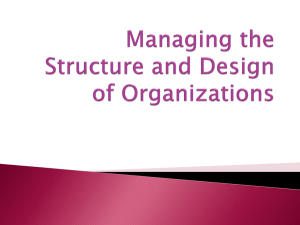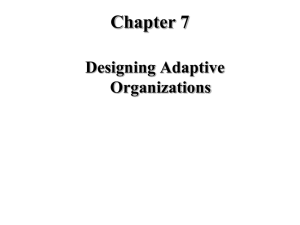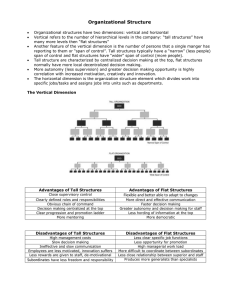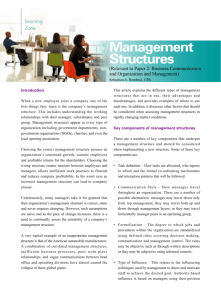Chap009
advertisement
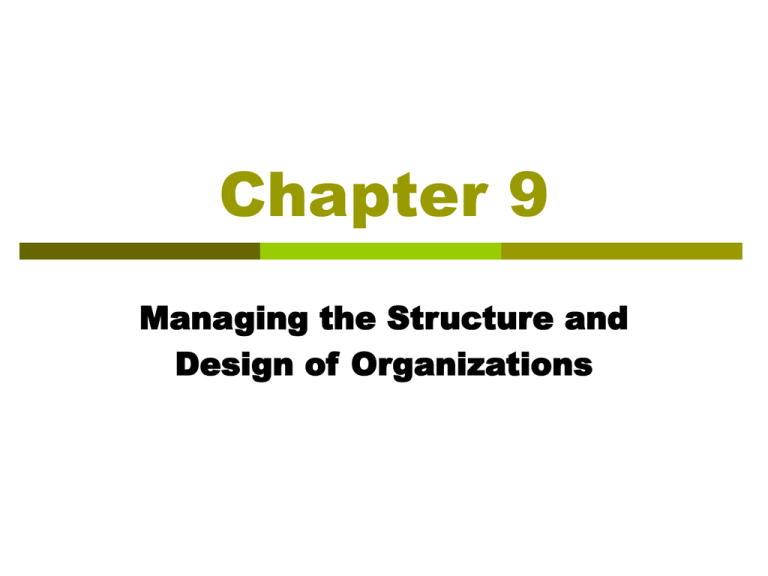
Chapter 9 Managing the Structure and Design of Organizations Learning Objectives After reading this chapter, you should be able to: Identify the vertical and horizontal dimensions of organization structure. Apply the three basic approaches-functional, divisional, and matrix-to departmentalization. Develop coordination across departments and hierarchical levels. Use organization structure and the three basic organization designs – mechanistic, organic, and boundaryless – to achieve strategic goals. Develop an awareness of strategic events that are likely to trigger a change in the structure and design of an organization. Daimler Shifts Gears The new CEO of DaimlerChrysler is making quite a bit organizational changes. How do the structural changes being made at Daimler respond to the company’s new goals? Why was the former structure no longer useful for reaching strategic goals? Organizing The deployment of resources to achieve strategic goals. It is reflected in: The organization’s division of labor that forms jobs and departments. Formal lines of authority. The mechanisms used for coordinating diverse jobs and roles in the organization. Strategy indicates what needs to be done. Organizing shows how to do it. Organization Structure Formal system of relationships that determine: Lines of authority – who reports to whom. Tasks assigned to individuals and units – who does what tasks and with which department. Dimensions structure: of organization Vertical dimension Horizontal dimension The Vertical Dimension of Organization Structure Unity of Command – a subordinate should have only one direct supervisor. A decision can be traced back from the subordinates who carry it out to the manager who made it. The Vertical Dimension of Organization Structure (continued) Authority – The formal right of a manager to make decisions, give orders, and expect the orders to be carried out. Line Authority Staff Authority Responsibility – the manager’s duty to perform an assigned task. Accountability – the manager (or other employee) with authority and responsibility must be able to justify results to a manager at a higher level in the organizational hierarchy. The Vertical Dimension of Organization Structure (continued) Line Authority entitles a manager to directly control the work of subordinates by hiring, discharging, evaluating, and rewarding them line managers hold positions that contribute directly to the strategic goals of the organization part of the chain of command Staff Authority the right to provide advice, recommend, and counsel line managers and others in the organization staff managers direct line managers The Vertical Dimension of Organization Structure (continued) Span of control – the feature of vertical structure that outlines: The number of subordinates who report to a manager. The number of managers. The layers of management within an organization. Smaller span – fewer employees supervised by a manager – creates a tall vertical organizational structure Larger span – greater number of employees supervised – creates a flat organizational structure The Vertical Dimension of Organization Structure (continued) Centralization – the location of decision authority at the top of the organization hierarchy. Decentralization – the location of decision authority at lower levels in the organization. Formalization – the degree of written documentation that is used to direct and control employees. Tall and Flat Structures The Horizontal Dimension of Organization Structure The organization structure element that is the basis for: Dividing work into specific jobs and tasks. Assigning jobs into units such as departments or teams. Departmentalization: Functional Divisional Matrix Functional Departmental Structure President Engineering Production Marketing Finance Advantages and Disadvantages of the Functional Approach Advantages Decision authority is centralized at the top of the organization hierarchy Career paths foster professional identity with the business function High degree of efficiency Economies of scale help develop specialized expertise in employees Disadvantages Communication barriers Conflict between departments Coordination of products and services is difficult Diminished responsiveness to customers’ needs Employees identify with functional department goals and not organization goals or needs of the customer Divisional Organization Structure President Computer Division Software Division Consulting Source Division Production Production Production Marketing Marketing Marketing Finance Finance Finance Geographic-Based Organization Structure President U.S. and Canada Division Latin America Division European Division Asian Division Advantages and Disadvantages of the Divisional Approach Advantages Coordination among different business functions Improved and speedier service Accountability for performance Development of general manager and executive skills Disadvantages Duplication of resources by two or more departments Reduced specialization in occupational skills Competition among divisions Matrix Organization Structure President Vice President Finance Region A Manager Region B Manager Region C Manager Vice President Operations Vice President Manufacturing Vice President Sales and Marketing Advantages and Disadvantages of the Matrix Approach Advantages Efficient utilization of scarce, expensive specialists Flexibility that allows new projects to start quickly Development of crossfunctional skills by employees Increased employee involvement in management decisions affecting project or product assignments Disadvantages Employee frustration and confusion as a result of the dual chain of command Conflict between product and functional managers over deadlines and priorities Too much time spent in meetings to coordinate decisions Coordination Mechanisms Meetings Organization-wide Reward Systems Task Forces and Teams Liaison Roles Integrating Managers Organizational Culture Organization Design The selection of an organization structure that best fits the strategic goals of the business. Basic organization designs: Mechanistic Organic Boundaryless These designs incorporate vertical and horizontal structural elements. Organization Design (continued) As business strategy changes, so do the structural elements of organization design. Strategic factors that affect the choices of organization design: Organization capabilities Technology Organization size Environmental turbulence Mechanistic, Organic, and Boundaryless Designs Mechanistic Organic Boundaryless Rigid hierarchical relationships Collaboration (both vertical and horizontal) Collaboration (vertical, horizontal, customers, suppliers, competitors) High formalization Low formalization Low formalization Top-down communication Informal communication Informal communication Centralized decision authority Decentralized decision authority Decentralized decision authority Narrowly defined specialized jobs Broadly defined flexible jobs Broadly defined flexible jobs Emphasis on individuals working independently Emphasis on teams Emphasis on teams that also may cross organization boundaries Redesigning Organizations Merger Acquisition Divestiture Downsizing Daimler Shifts Gears Changes in structure are intended to enable company to move faster and with more flexibility Competitive threats Recapture preeminent position in industry Also intended to cut costs Previous structure had duplication (partly due to merger/acquisition) and distanced management from core of business. Focus: back to basics In-class exercise Apollo 13 Write: what type of structure is illustrated? what type of organizational design is illustrated? Discuss with your neighbor Video: One Smooth Stone Write your response to first discussion question bottom of p. 384. Now exchange with your partner and compare and contrast with Apollo 13. Individual/Collaborative Learning 9.1 (p. 382) On a sheet of paper, respond to the first question. Work on the Collaborative Learning Exercise with two other students. On your sheet of paper, write the ONE conclusion that you found most interesting.
